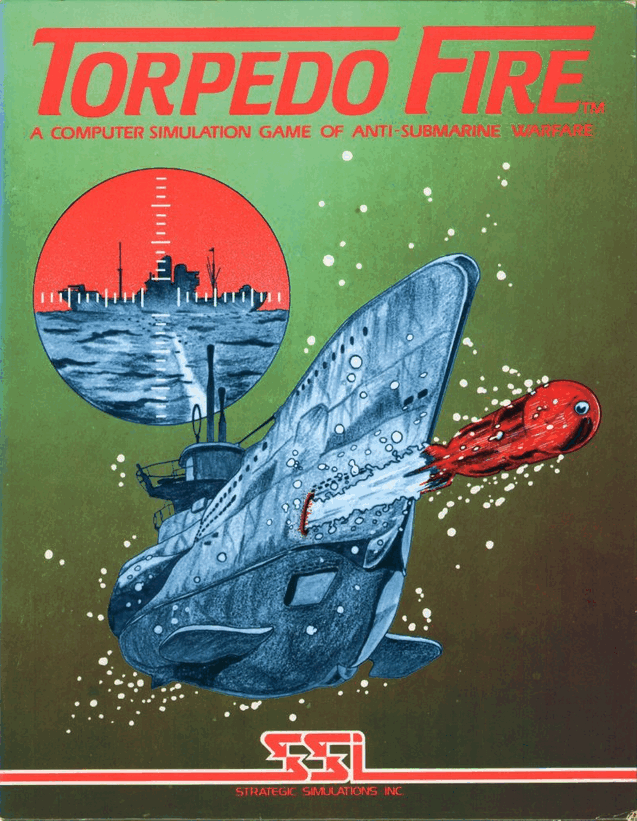
Torpedo Fire by John Lyon, published by Strategic Simulations, USA
First release : April 1981 on Apple II
Tested on : Apple II
Total Hours Tested : 5
Average duration of a battle : From 1 hour to forever.
Difficulty: Complex (3/5) due to the number of manual (or spreadsheet) calculations.
Would recommend to a modern player : No
Would recommend to a designer : No
Final Rating: 10/100
Torpedo Fire completes SSI’s line-up with another type of modern warfare that had not been covered yet on computer : battles between submarines and escorts. As such, it was positioned as a premium game, with some of the best box content ever released by SSI :
- A manual,
- An empty map and a pen to take notes,
- A protractor to measure angles on said map
- Four reference cards :
- A list of escorts and their stats,
- A list of submarines and their stats,
- A list of commands,
- A guide for scenario creation
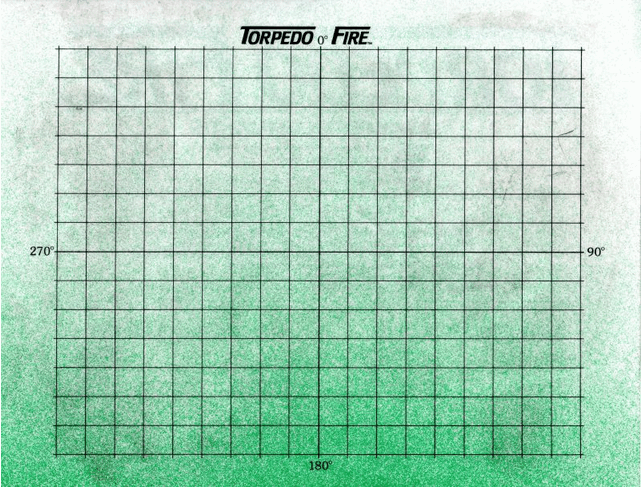
The game was ambitious in something else : uniquely, it featured asymmetric UI.
- The submarine player could not access any “top-view” map, only a radar and a “subjective” view through the periscope. If the submarine was too deep, the submarine player would be effectively blind,
- The escort player has the comfort of a more traditional bird’s eye view.
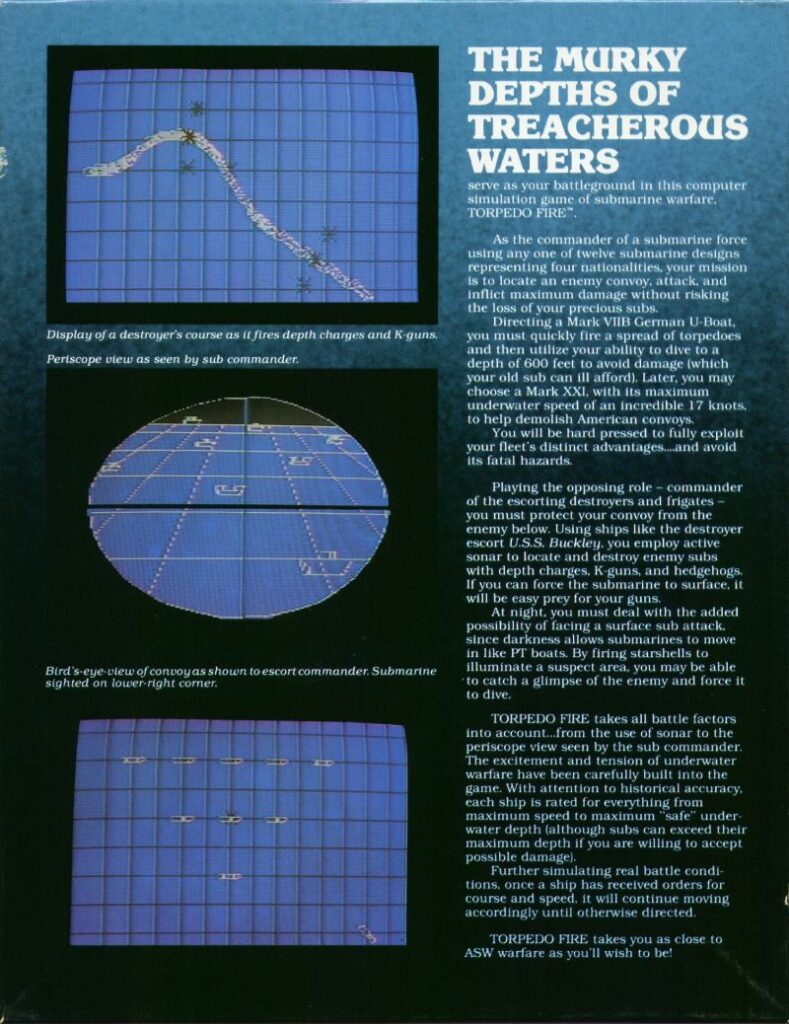
The ambition and promise was there and then… something happened, not sure what, and the game was released in a status of obvious beta. Unlike so many early SSI games, Torpedo Fire never received a 1.1 version either, so the game remains in this sorry state 40 years later.
A. UI , Clarity of rules and outcomes
As I said in the intro, the game has different UIs for escort and for submarines.
Escort side
The escort UI is clear enough, though tedious to use. The most frustrating problem for the escort is a consequence of the collision rules : your ships are displayed with a standard size that does not vary with the map zoom. It gives the impression that ships are going to pass next to each other without problem, but the iron rule of “ships are actually disks of radius 150 yards” will catch the player back again and again, and wreck their ships.

That’s for the navigation. Then there are more problems when trying to fight :
- When using surface guns, given all shots happen at the beginning of the turn and hit instantly, it would have been easy for the game to let you point a target directly, or at least point at coordinates. But no, you need to input an objective angle (related to the map, not to your ship) and a distance, both of which you have to calculate.
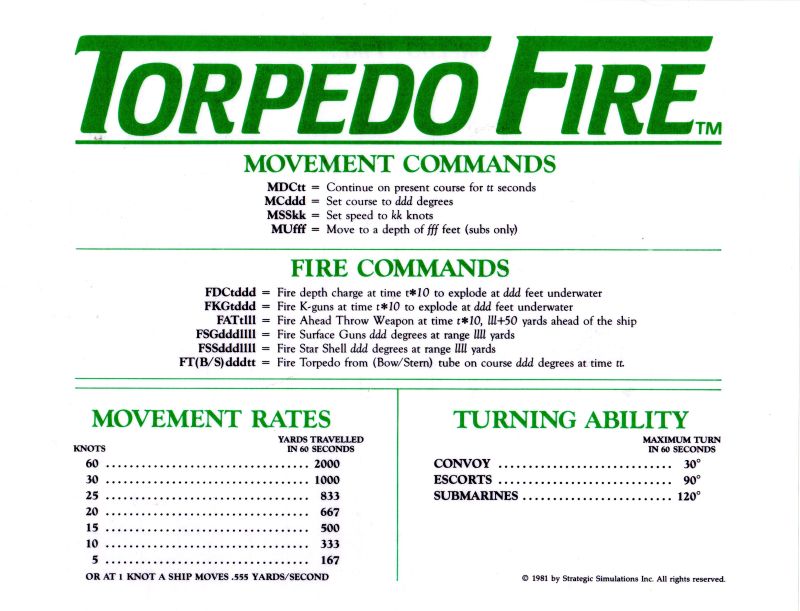
- As for the anti-submarine weapons, the problem is the amount of text to write. Let’s be honest, if you go after a sub you are going to be all-in with these and that’s a minimum of 4 and more commonly 7 or 8 attacks. For each of them you need to input the 3-letters code for the weapon, the timing of the release of the weapon in the turn and the depth. A command that would have allowed the player to say “send depth charges at depth D for 40 seconds starting at X seconds ” would have shortened orders a lot.

So in a nutshell, the escort side suffers from command inflation, and a map that does not help you avoid collision. Now, what about the submarines ?
Submarine side
In a nutshell, it is worse.
- The radar screen displays what is seen on radar or on periscope, at such it can only be used at periscope depth (30) and above. It is not really useful except to have a general idea of what is around :

This means that the user is going to rely mostly on the periscope (even if the submarine is surfaced, the player has to use the periscope – standing on the kiosk is verboten!) :
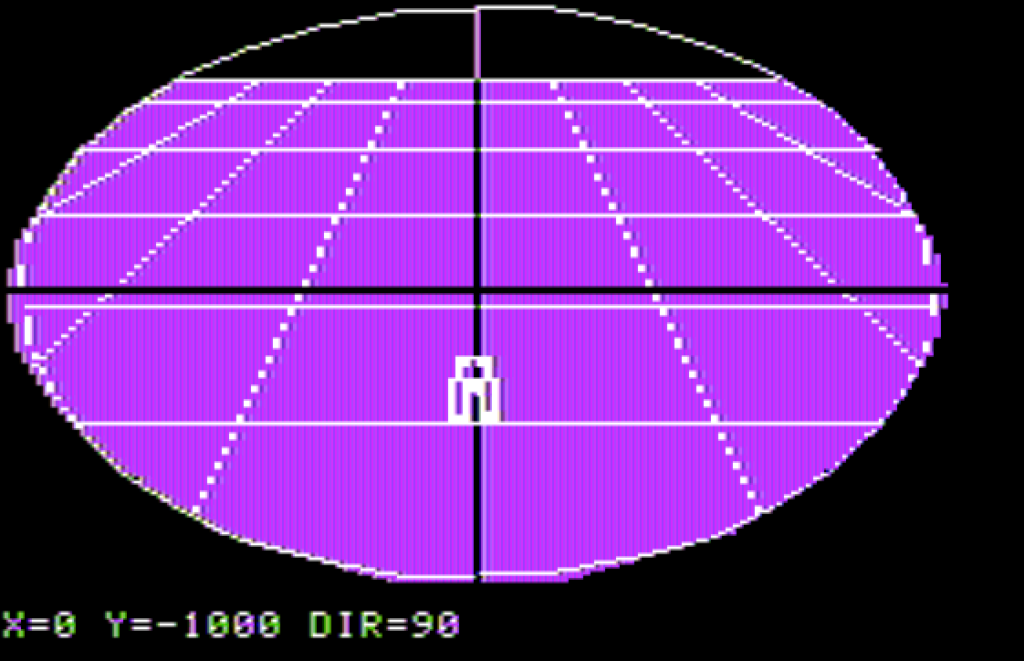
Now, as you rotate the periscope, the angle of the ships you are observing changes as if you had moved.
Same situation, rotation of periscope below :

The pro is that it helps identify ships. The con is that to guesstimate the bearing of the ship you need to point exactly at it, and also that it is an obvious bug.
And… that’s all. I could navigate with that in Silent Hunter III, but given the level of graphics and the fact you can only check what happens around you every turn (60 seconds in “real time”) it is extremely hard to do anything with a submarine in Torpedo Fire.
And there is the the firing part. Submarines can use their surface gun (except if it is the Type XXI, of course), but if they want to fire a torpedo, the player will have to type an angle and hope for the best.
Of course, the player could try to use the Torpedo Data Computer (TDC) but I am not sure it helps much :
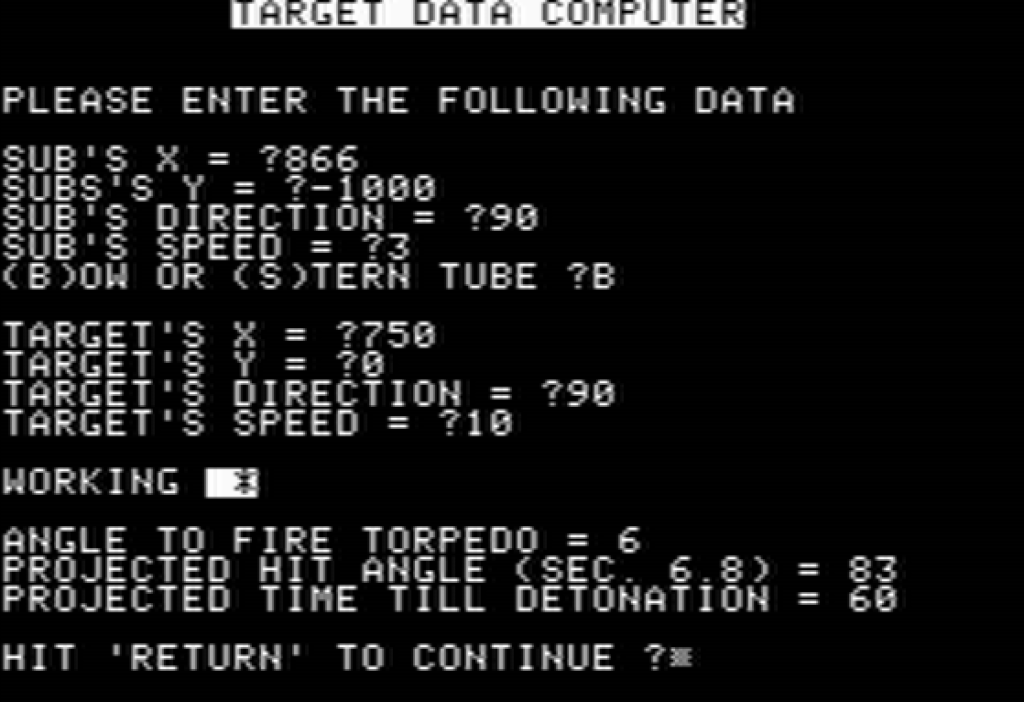
The player needs to input a lot of data to use the TDC. The sub’s data are obvious (but still require a back&forth with the status menu) but good luck determining your target’s direction and even worse its speed with just the periscope and 60 seconds intervals between two turns – especially since of course you have your own speed to take into account.
Playing the submarine side is just brutally hard and I am relieved that the solitaire mode is escort only.
Score : 2/20, it would have been 0/20 if I had to play the submarine side.
B. Immersion (Settings & Graphics)
In terms of immersion, no pun intended, the game barely grazes the surface. The basics of submarine warfare are there : you throw depth charges hoping to force the submarine to surface or hoping to sink it altogether and the faster you go the less efficient your sonar is. But that’s pretty much all.
There are a few things you would expect from a submarine game that are quite simply not there :
- There is no limit to how long a submarine can stay underwater (granted, with turns of 1 minute that limit would have realistically been very high),
- There is no limit on how many torpedoes or depth charges you can send,
- Sonars have perfect 360° coverage,
- The weather is always neutral,
- There are no planes
There is very little sense of the progress of technology. Whether you fight in 1939-1941 or in 1944-1945, every single escort has sonar & radar with exactly the same capacities. There is no “happy time” for the submarines.
There are two exceptions to the “everything is always pretty much the same” :
- Early American torpedoes have only 50% chance of detonating,
- Japanese radar max range is 2 000 yards (4 000 yards for all other countries).
There are some differences between the destroyers, especially between countries, though within the same country several ships are almost copies of one another in terms of stats, except for HP (usually sucked up fully by one torpedo anyway) and a few knots of speed – still you can make a few interesting design decisions for your scenarios here.

As for graphics, all I can say is that they exist. Though I have to say that even if I had achieved some kind of suspension of disbelief, this kind of display issue would have been an immersion breaker :
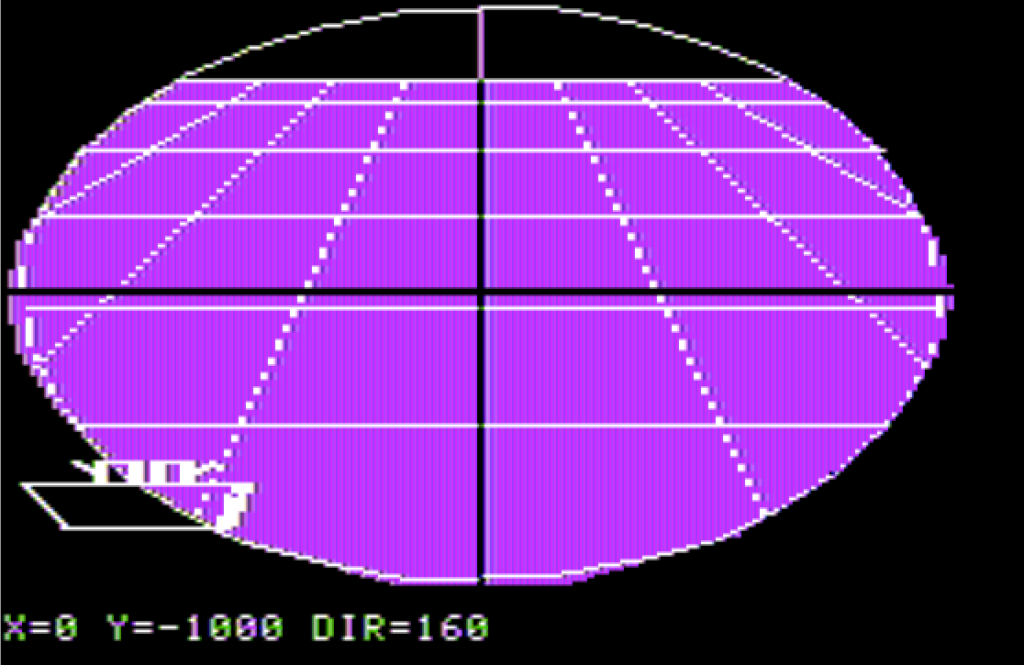
Score : 3/20
C. Systems
I think how the game works is made clear by the After Action Report. The only thing remaining to say is about the impact of day and night (and the rule for visual search) :
- By day, a sub can spot a surface ship on periscope at 3 000 yards (double that if the sub is surfaced), by night at 1 500 yards only,
- By day, a surface ship can see a surfaced sub to up to 6 000 yards, but with some randomization. At 3 000 yards, it has 50% chance of seeing it. By night, the max view distance is 1 000 yards,
- By day, a surface ship can see a periscope at up to 1 000 yards. It cannot see a periscope at night,
- Escorts can shoot two star-shells by turn to illuminate an area of 600 yards in diameter as if it was the day – something I never had to do, because day or night the radar has a range of 4 000 yards (except for the Japanese radar) and gives the same information as a visual contact,
- There is 10% chance a turn that the radar has a “false contact”. It rarely happens, and in the rare cases where it happened it did not fool anyone.

So, if I don’t take into account the UI, the bugs, the terrible AI, the fact that all eras play the same, does the system work ?
Sadly, no. The core issue is that 60-second turns are just too long. One turn you are on the tail of the submarine, the following turn it turns left, you continue straight away for 60 seconds, and now it will take you several turns to turn and come back. You need to be lucky to be in a position where you have a chance to hit the submarine with depth charges the following turn.
This very rarely happens, so I would compare the final outcome to Computer Air Combat : you try to close on the sub, overshoot it due to the length of a turn, then spend several turns coming back, overshoot it again, etc… In Computer Air Combat, it will last seemingly forever. In Torpedo Fire, it will typically end when your destroyers will inevitably collide.
I wish this game asked me how long I want each turn to be, like in Computer Ambush. 15-second turns when close to the submarine would have been way more manageable.
Score : 1/20
D. Scenario design & Balancing
There is only one “tutorial” scenario, which despite its name is balanced between both sides. After that, it is scenario editor time, where you basically pick the list of escorts, submarines (there can be several) and the number and type of merchant ships.
You can have Americans fighting Americans, but you cannot mix destroyers or submarines from different countries. The escorts and ships are placed when you design the scenario (the game tells you it is positioning the merchant ships on its own, but actually it is putting all of them at coordinates 0,0 so if you don’t want them to be on top of each other, you better reposition them). Submarines are going to be randomly positioned when launching the battle.
If you are feeling bold, you can try to edit ships, but it is not a very welcoming menu, nor is it easy to use :

Scenarios are allocated to a data disk, and you need to swap disks every time you want to create or launch a scenario. I forgot to do it once when saving a scenario, and I destroyed my Torpedo Fire file. I wonder if in the 1980s users could overwrite their own game.
When you launch the scenario, you have only two customization options : day/night and beginner mode. In beginner mode, the depth charges have a bit more reach, and players are informed when their depth charges blow up not too far from a submarine.
As for the AI, as per my After Action Report it is terrible at night. During the day, it is better as it never surfaces and always remains at periscope depth. I suppose it is coded to surface during the night because it is less afraid to be seen (despite radars) and because periscope view is limited to a maximum range of 1 500 yards.
Score : 3/20
E. Fun and replayability
Between having to prepare an Excel file to actually shoot at targets, struggling against the UI and randomly colliding with my own ships, I did not have any fun with the game. I give one point for the replayability offered by the scenario editor.
Score : 1/20
F. Final rating
10/100.
Contemporary Reviews
Torpedo Fire reviewers mostly either loved it or hated it.
The haters shot first. As soon as July 1981, the Space Gamer covers Torpedo Fire in one of their “Capsule Reviews”. Forrest Johnson starts by listing the many issues of the game (including “impossible to fire the surface guns without the use of trigonometry“) and then continues : “I might be able to forgive all this if the game were enjoyable, but I did not find it so (…) it might be realistic, but it makes for a dull simulation“. The conclusion is clear : “I cannot help but feel that Strategic Simulations has taken a wrong turn somewhere.“
One of the lovers was Bob Proctor from Computer Gaming World. Torpedo Fire is one of the four games that received a long review in the first issue (November 1981). Bob Proctor ran into the same problems as I did (for instance “it’s not at all unusual for surface ships to run into each other in the first few games“, or the issue with the angle of view changing when you rotate the periscope). Yet, “Torpedo fire is an excellently conceived game. Fortunately, its faults do not keep it from being fun and exciting, nor do they keep it from being the best simulation of a confrontation between submarine and destroyer presently available.” Bob Proctor also points out than unlike earlier SSI games, this one has rather fast turn resolutions (two minutes).
Proctor actually likes the game so much that he comes back to it one year later in CGW (November 1982) to propose two scenarios : one about an American submarine crossing the straight of Bungo Suido (apparently that straight was historically well-patrolled by the Japanese), another is about the damaged Japanese carrier Shokaku being intercepted as it was towed to safety.
Another review firmly on the loving side is from the FrenchTilt. In their coverage of existing wargames in March 1984, they list Torpedo Fire as the best naval wargame on the market. It receives a 5 out of 6.
The best middle ground might be the 1982 book of Apple Software, which sees both what the game is and what it could have been : “The game is long, slow and tedious, but it is interspersed with high-tension excitement“. After two full paragraphs of flaws, it concludes : “A streamlined and cleaned-up version with better graphics would be a better value even at a higher price. Until then, an underwater version of Computer Air Combat it is not”. Alas, there would be no streamlined and cleaned-up version of Torpedo Fire.
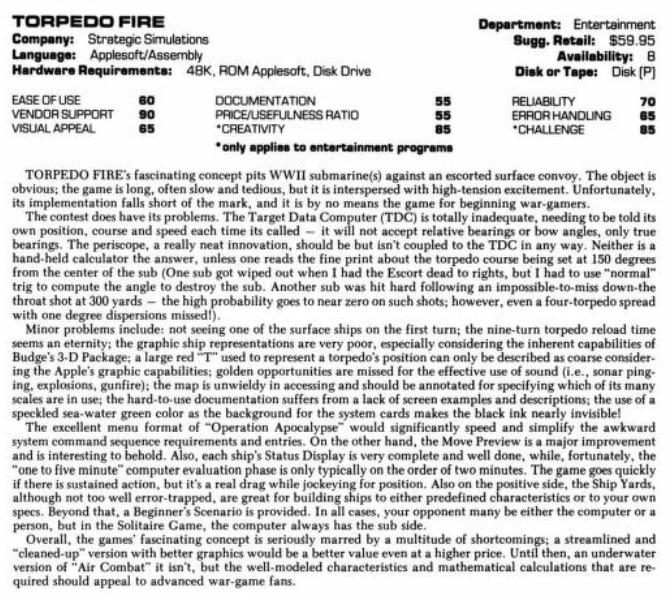
Side note that I had no idea where to put : I believe Torpedo Fire is the first game with cross-promotion (during the first search phase of each game).
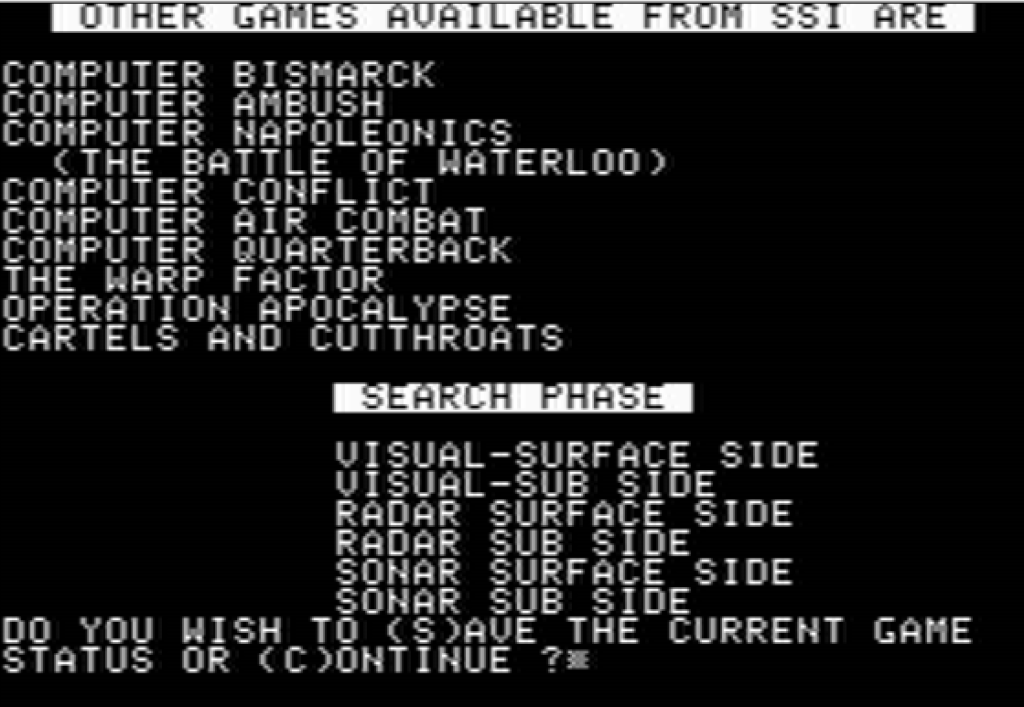
2 Comments
Same question as for Computer Air Combat: did people really use it ? I would just put the protractor on my screen !
A nice 26″ monitor today might run you a hundred or so dollars, but a monitor in 1981? I have to imagine that this was substantially more expensive and you wouldn’t risk scratching the glass with a protractor. Same thing with a television set.
You’d just get out your stack of semi-translucent tracing paper and laboriously plot out your firing solutions all night.
Good point. Also, I remember that the monitors I used when I was a kid were curved, so maybe you could not use a protractor ?
That would make sense in Torpedo Fire then, though for Air Combat I am still not sure 🙂